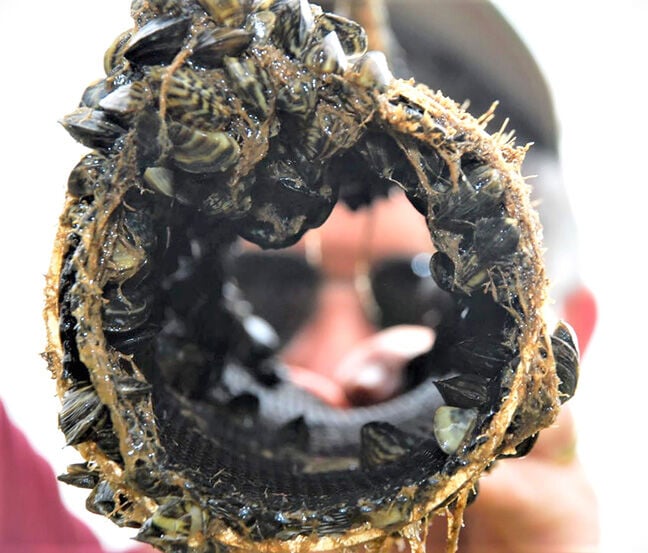Experts warn aquarium products could contain invasive zebra mussels - Bryan-College Station Eagle
Experts warn aquarium products could contain invasive zebra mussels - Bryan-College Station Eagle |
| Experts warn aquarium products could contain invasive zebra mussels - Bryan-College Station Eagle Posted: 11 Apr 2021 10:00 PM PDT   Zebra mussels can clog water pipes, cooling intakes on boat motors and almost anything else left in the water in infested lakes. A Texas A&M AgriLife Extension Service aquatic expert is trumpeting recent warnings by national and state agencies regarding retail moss balls that may be infested with invasive zebra mussels. Brittany Chesser, AgriLife Extension aquatic vegetation program specialist in the Department of Rangeland, Wildlife and Fisheries, Bryan-College Station, said the moss balls, a species of algae that form green balls up to a few inches in diameter, are sold at retail stores and online as an aquarium plant. Some of the moss balls, which are sold under such names as Beta Buddy Marimo Balls, Mini Marimo Moss Balls and Marimo Moss Ball Plant, have been found to contain zebra mussels. While the moss balls generally contain species typically nonnative and also noninvasive, zebra mussels are a highly invasive species that previously have been found in Texas waters. State officials have expressed the need to prevent their spread and introduction into new bodies of water in the state. Zebra mussel-infested moss balls have been confirmed in pet stores in 34 states from Alaska to Texas, according to the North American Invasive Species Management Association. NAISMA and its PlayCleanGo program urge aquarium owners to inspect their fish tanks for the presence of zebra mussels and take action by following the U.S. Fish and Wildlife Service's "Destroy, Dispose, Drain" strategy. Chesser said aquarium products can carry harmful hitchhikers like zebra mussels, snails and plant fragments of invasive species. Prohibited aquatic organisms, including plants, are illegal to release in public waters, and to import, sell, purchase, possess, transport or propagate. This includes seeds, fragments, hybrids or subspecies. These products typically meet federal guidelines, but not necessarily state requirements regarding plant and animal species, Chesser said. Many of these products are imported from around the world and therefore could introduce a variety of foreign aquatic plant or animal species to the state. "Studies show most retailers don't understand what they are selling if the product could be a detriment to native ecology or if the product is mislabeled," she said. Prevent the spread of zebra musselsTexas Parks and Wildlife Department (TPWD) officials said pet stores have been warned about the potential presence of zebra mussels in the moss balls, and that retailers were working to remove the products from their shelves and discontinue future sales. Chesser said aquarium owners who purchased moss balls should consider them contaminated and dispose of them properly according to the U.S. Fish and Wildlife Service and TPWD's guidelines. The aquarium or ornamental trade is a major contributor to the introduction of many aquatic plant species listed on federal or state noxious weed lists, Chesser said. Invasive plant and animal species pose a threat when unwitting pet owners empty aquarium tanks into native ecosystems. Once an organism is introduced, she said, it is very difficult and costly to control its spread, and many times impossible. Well-known examples of invasive species introduction to native ecosystems include water hyacinth, which is a listed noxious plant in Texas, and giant salvinia, a federally listed noxious plant, both of which were introduced from South America. Water hyacinth is believed to be initially introduced during World's Industrial and Cotton Centennial Exposition in 1884, and giant salvinia is believed to have been introduced in 1995. Controlling both water hyacinth and giant salvinia represent a considerable portion of the $137 billion spent in the U.S. each year to prevent invasive species from spreading and monitoring and controlling established plants. "This instance is an unpleasant reminder about the risks associated with buying aquatic organisms from retailers in person and online," Chesser said. "While most aquatic plant species consumers will come across are nonnative, noninvasive plants — meaning human intervention is required for them to reproduce and overall survive — there is still the likelihood of a nonnative, invasive species causing economic, environmental or human health harm. We never know what the next invasive introduced to our native ecosystems will be." Zebra mussels, what to look forZebra mussels are native to Eurasia, according to NAISMA. The species severely disrupts food webs, starves native species, encrusts aquatic infrastructure such as aquaculture operations, and reduces recreational opportunities. According to the University of Georgia — Center for Invasive Species and Ecosystem Health, zebra mussels have a small triangular shell with a sharply pointed umbo, or hinge end. The prominent dark and light banding pattern on the shell is the most obvious characteristic. The outer covering of the shell is generally well-polished, typically light tan in color with broad, dark bands across the shell. These bands can be either smooth or zigzag in shape. The presence of byssal threads distinguish them from native species and allow them to attach to surfaces. Zebra mussels are highly invasive and have caused economic and ecological damage when released into the wild, according to the TPWD. And these aquarium products pose a risk of this species being introduced into new water bodies in Texas, thereby causing serious harm. "Zebra mussels have already been introduced into many Texas lakes and are causing changes to the ecosystem along with damage to boats, water supply and control infrastructure," said Brian Van Zee, TPWD Inland Fisheries regional director. "It is important that we take all possible precautions to prevent them from being introduced elsewhere." |
| You are subscribed to email updates from "aquarium tank online" - Google News. To stop receiving these emails, you may unsubscribe now. | Email delivery powered by Google |
| Google, 1600 Amphitheatre Parkway, Mountain View, CA 94043, United States | |
Comments
Post a Comment